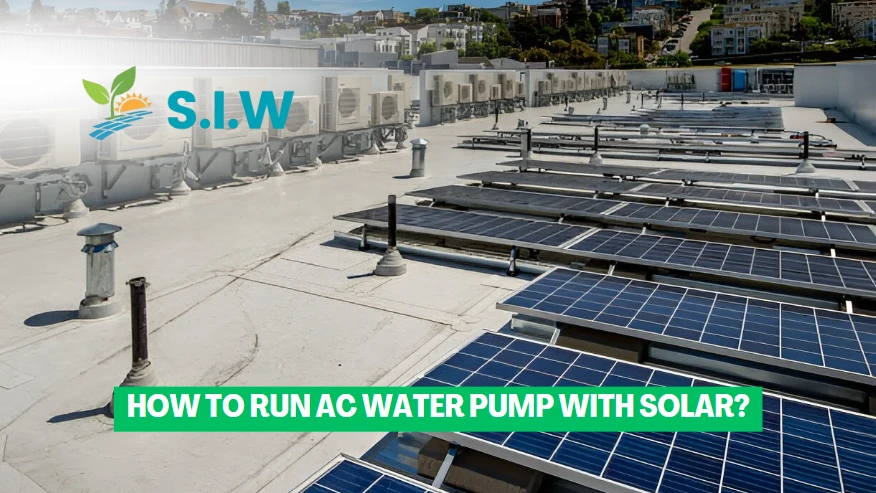In today’s eco-conscious world, utilizing solar energy to power various systems has become a smart and sustainable choice. Among the numerous applications of solar energy, running an AC water pump is a compelling option for those seeking to reduce their environmental footprint and energy costs. This comprehensive guide will walk you through the process of powering an AC water pump with solar energy, ensuring a reliable and efficient system.
Understanding AC Water Pumps
AC water pumps are commonly used in various applications, including irrigation systems, water features, and cooling systems. These pumps are powered by alternating current (AC) and are known for their efficiency and durability. When paired with solar power, they offer a sustainable alternative to traditional energy sources.
Why Choose Solar Power for Your AC Water Pump?
Switching to solar power for your AC water pump offers several advantages:
- Cost Savings: Reduces electricity bills by harnessing the free energy from the sun.
- Affect on the Environment: Minimizes your carbon footprint and reliance on fossil fuels.
- Reliability: Provides a dependable power source, especially in remote or off-grid locations.
- Sustainability: Contributes to long-term energy solutions and reduces dependence on non-renewable resources.
Key Components of a Solar-Powered AC Water Pump System
To effectively run an AC water pump with solar power, you’ll need the following components:
1. Solar Panels
Solar panels are the heart of your solar power system. They convert sunlight into electricity. The size and number of panels required depend on the power needs of your AC water pump and the average sunlight available in your location.
2. Charge Controller
A charge controller regulates the voltage and current coming from the solar panels to prevent overcharging the battery and to ensure the efficient operation of the pump.
3. Battery Storage
Batteries store the energy generated by the solar panels for use when sunlight is not available. The capacity of the battery bank should match the energy requirements of your AC water pump and the expected duration of use.
4. Inverter
An inverter converts the direct current (DC) electricity from the solar panels and batteries into alternating current (AC) required by the water pump. Choose an inverter with sufficient capacity to handle the power load of your pump.
5. AC Water Pump
Select an AC water pump that is compatible with your system. Ensure it meets the flow rate and pressure requirements for your application.
Installing Your Solar-Powered AC Water Pump System
Step 1: Assess Your Energy Needs
Before installation, calculate the energy requirements of your AC water pump. This includes understanding the pump’s power consumption in watts and its operational hours.
Step 2: Choose the Right Solar Panels
Based on your energy needs, select solar panels with the appropriate wattage and efficiency. Consider factors such as panel size, installation space, and local solar irradiance.
Step 3: Install the Solar Panels
Mount the solar panels on a stable structure, preferably facing the sun to maximize energy capture. Ensure proper wiring connections to the charge controller.
Step 4: Set Up the Charge Controller
Connect the solar panels to the charge controller. The charge controller will then be connected to the battery storage system to regulate energy flow and protect the batteries.
Step 5: Install the Battery Storage
Place the batteries in a well-ventilated and secure location. Connect them to the charge controller and ensure proper connections to the inverter.
Step 6: Connect the Inverter
Attach the inverter to the battery bank and ensure it is properly configured to convert DC to AC power. Connect the AC water pump to the inverter output.
Step 7: Test the System
Power up the system and test the AC water pump to ensure it operates correctly with the solar power setup. Check for any issues with connections and adjust settings as needed.
Maintenance and Troubleshooting
Regular Maintenance
- Inspect Solar Panels: Clean and check the panels periodically to ensure they are free from debris and dirt that could impact performance.
- Monitor Battery Health: Regularly check battery levels and connections to ensure proper function and longevity.
- Check Inverter Performance: Ensure the inverter operates efficiently and without errors.
Troubleshooting Common Issues
- Pump Not Working: Verify connections, check battery charge levels, and ensure the inverter is functioning correctly.
- Low Water Pressure: Assess the pump’s performance, check for blockages, and ensure the solar panels are receiving adequate sunlight.
Conclusion
Running an AC water pump with solar power is a practical and environmentally friendly solution that offers numerous benefits. By carefully selecting and installing the right components, you can create an efficient solar-powered system that meets your water pumping needs while contributing to a more sustainable future.








